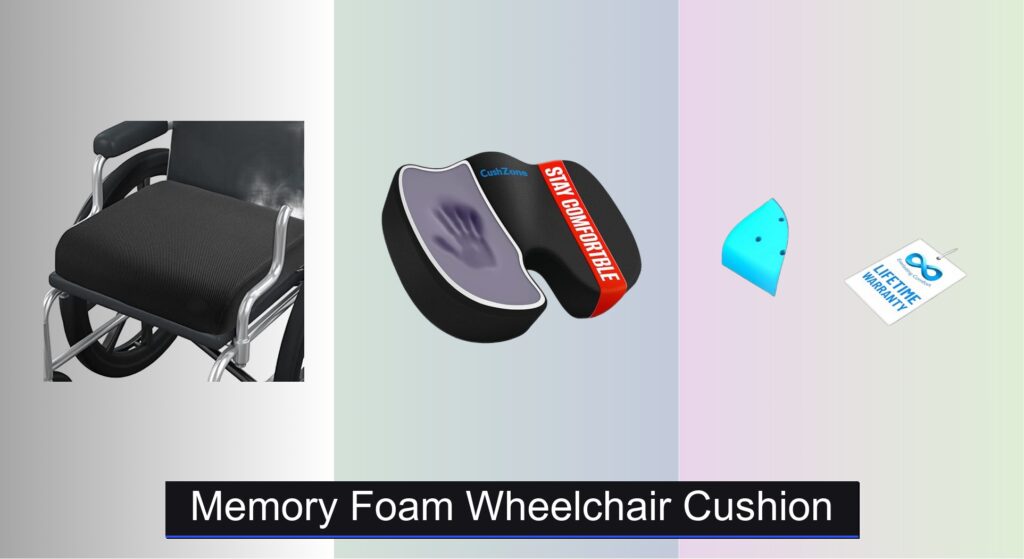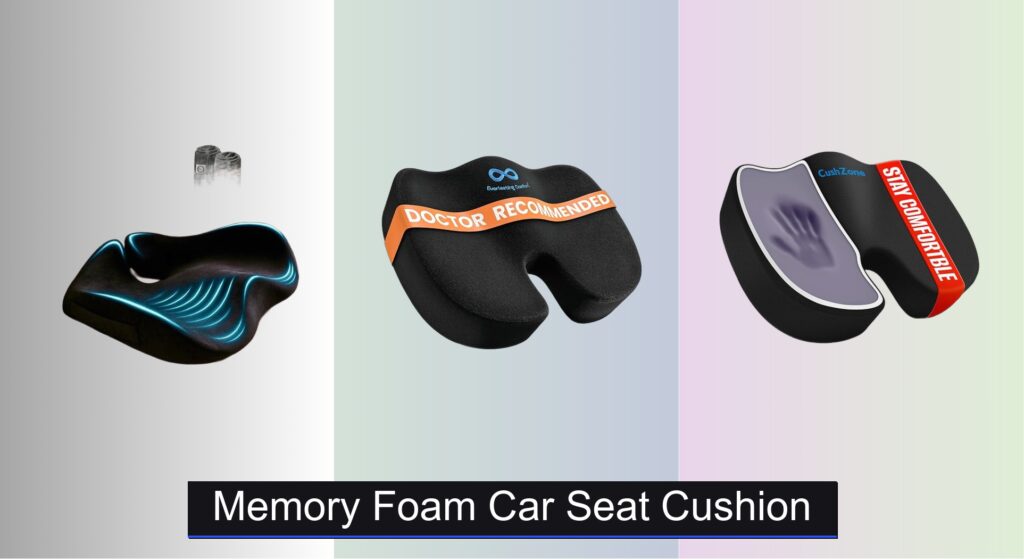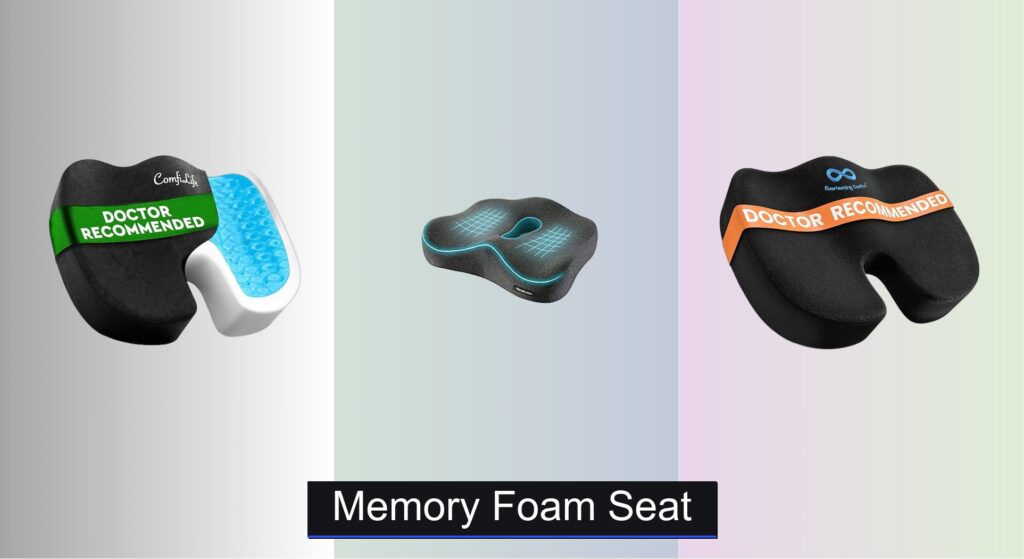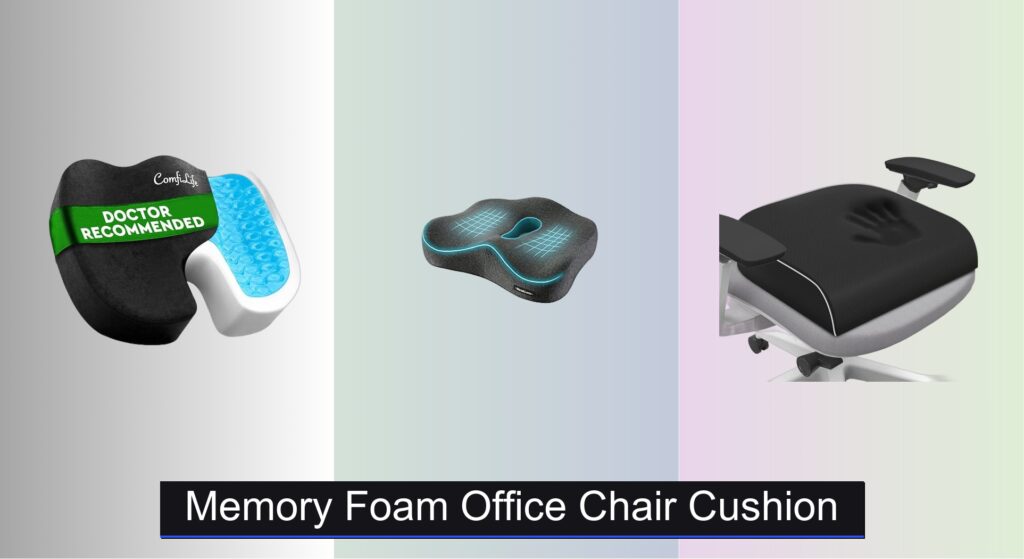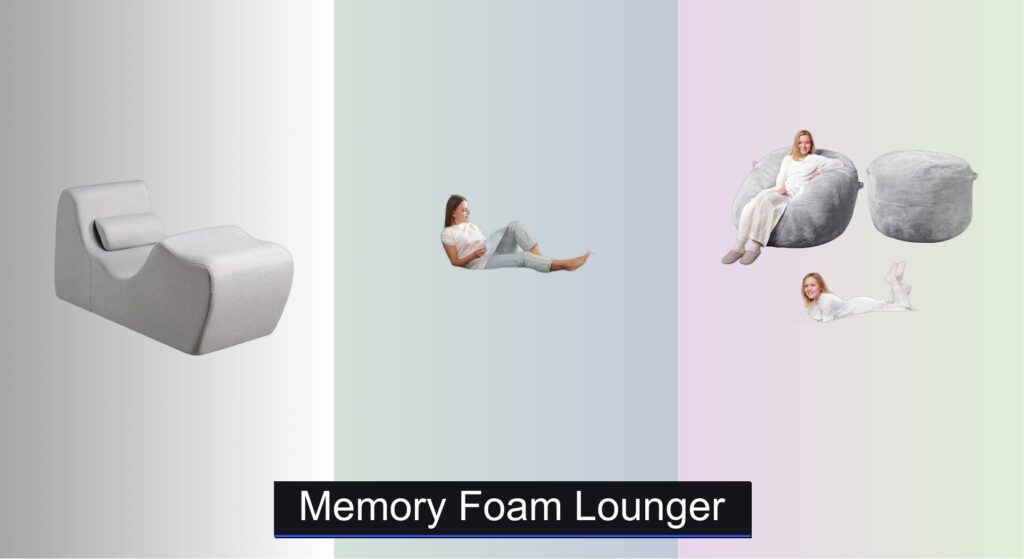Sitting for long periods in a wheelchair can lead to discomfort, pressure sores, and poor posture—especially without proper support. Many users struggle with overheating, inadequate cushioning, or cushions that lose shape over time, compromising both comfort and health. A high-quality memory foam wheelchair cushion helps distribute weight evenly, reduce pressure on sensitive areas like the tailbone and hips, and improve overall seating posture.
We analyzed over 50 models, evaluating foam density, cooling technologies, pressure relief features, and real-world user feedback to identify the best options. Our picks prioritize durability, breathability, and targeted support—balancing performance, value, and comfort. Whether you need relief from sciatica, enhanced airflow, or a cushion that retains its shape, our top choices deliver where it matters most. Keep reading to find the ideal memory foam wheelchair cushion for your needs.
Best Options at a Glance

YOUFI Thick Gel & Memory Foam Cushion
Best Overall
- 18″ x 16″ x 4″
- Memory Foam & Gel
- Breathable Mesh
- Non-Slip
- Carry Handle

Everlasting Comfort Gel Memory Foam Cushion
Best for Heat Relief
- Gel Memory Foam
- OEKO-TEX STANDARD 100
- Ventilated Design
- Removable, Non-Slip
- Wheelchair, Office, Car

HAVARGO Dual-Layer Anti-Sagging Cushion
Best for Stability
- 18 x 16 x 3 in
- Dual-layer foam
- Shredded memory foam
- High-density foam
- Silicone dot fabric

Medtropix Thick Memory Foam Cushion
Best for Seniors
- Memory Foam
- Water Resistant
- Removable Washable
- Pressure Relief
- Elderly/Seniors
Memory Foam Wheelchair Cushion Review
How to Choose the Right Memory Foam Wheelchair Cushion
Choosing the right memory foam wheelchair cushion can dramatically improve your comfort, posture, and overall well-being, especially if you spend significant time seated. Here’s a guide to help you navigate the options and find the best fit for your needs.
Core Material & Density: Memory Foam vs. Gel Memory Foam
The heart of any memory foam cushion is, well, the memory foam! But not all memory foam is created equal. Density is a key factor – higher density foams offer more support and durability, resisting flattening over time. However, very dense foam can feel firm and less comfortable for some. Many cushions combine memory foam with gel infusions. Gel infusions help regulate temperature, preventing overheating during prolonged sitting, which is a significant benefit for those prone to sweating or living in warmer climates. Standard memory foam is a good all-around choice for general comfort and pressure relief. Consider your weight and typical sitting duration; heavier individuals and those sitting for extended periods will likely benefit from higher-density foam or gel-infused options.
Pressure Relief & Coccyx Cutout
A primary goal of a wheelchair cushion is to alleviate pressure on sensitive areas like your tailbone, hips, and lower back. Cushions featuring a coccyx (tailbone) cutout are specifically designed to remove pressure from this area, which can be particularly helpful for individuals with sciatica, hemorrhoids, or chronic tailbone pain. The cutout suspends the tailbone, preventing it from bearing weight. Without a cutout, the pressure is distributed across a wider area, which may be preferable for some, but won’t provide the targeted relief of a cutout design.
Cushion Size & Shape
Getting the right size is crucial. Most cushions are rectangular, but their dimensions vary. Measure your wheelchair seat (length and width) to ensure the cushion provides adequate coverage without being too large or small. A cushion that’s too small won’t offer enough support, while one that’s too large might feel awkward and interfere with movement. Beyond dimensions, consider the cushion’s thickness. Thicker cushions (3 inches or more) generally offer more support and pressure relief, while thinner cushions (under 2 inches) are more portable and may be suitable for shorter periods of sitting.
Additional Features to Consider
- Cover Material: Breathable mesh covers are ideal for promoting airflow and preventing overheating. Removable, machine-washable covers are a huge convenience for maintaining hygiene.
- Non-Slip Bottom: Essential for safety and stability, a non-slip bottom prevents the cushion from sliding around on the wheelchair seat.
- Portability: If you need to transport your cushion frequently, look for models with a built-in carry handle.
- Construction: Dual-layer designs (like a softer top layer over a firmer base) can offer a balance of comfort and support.
Memory Foam Wheelchair Cushion Comparison
| Product | Best For | Dimensions (approx.) | Key Comfort Features | Cover Material & Washability | Portability | Pressure Relief | Cooling Features | Non-Slip Bottom |
|---|---|---|---|---|---|---|---|---|
| YOUFI Thick Gel & Memory Foam Cushion | Best Overall | 18″ x 16″ x 4″ | Super Thick Gel & Memory Foam, 4″ Memory Foam | Breathable Mesh, Machine Washable | Carry Handle | Back, Legs, Hips, Sciatica | Gel Layer & Breathable Mesh | Yes |
| CushZone Ergonomic Memory Foam Cushion | Best Budget Friendly | 18″ x 14.2″ x 3.15″ | U-Shaped Cutout, Contoured Shape | Breathable Mesh, Machine Washable | Handle | Tailbone, Lower Back | Breathable Mesh | Yes |
| Everlasting Comfort Gel Memory Foam Cushion | Best for Heat Relief | Not Specified | Memory Foam, Ventilated Gel Design | Not Specified | Not Specified | Tailbone | Ventilated Gel Design | Not Specified |
| CYLEN Gel Infused Memory Foam Cushion | Best for Pressure Relief | 17.7″ x 15.75″ x 2.95″ | Coccyx Pressure Relief, Gel Infused Foam | Breathable Mesh, Removable & Washable | Not Specified | Sacrum, Tailbone | Gel Infusion | Yes |
| HAVARGO Dual-Layer Anti-Sagging Cushion | Best for Stability | 18″ x 16″ x 3″ | Dual-Layer Foam (Memory Foam & High-Density Foam), Curved Bottom | Soft Fabric, Removable & Washable | Carry Handle | General | None Specified | Silicone Dot Fabric |
| AUVON Cooling Gel Wheelchair Seat Cushion | Best for Cooling Comfort | 18″ x 16″ x 3″ | Ventilation System, Gel Layer, Memory Foam | Ice-Silky Fabric, Removable & Washable | Carry Handle | General | Cooling Gel Layer, Ventilation Grooves, Ice-Silky Fabric | Yes |
| Medtropix Thick Memory Foam Cushion | Best for Seniors | Not Specified | Premium Memory Foam | Water & Stain Resistant, Machine Washable | Not Specified | General | None Specified | Not Specified |
| TravelMate Extra-Large Memory Foam Cushion | Best for Large Fit | Not Specified | Dual-Layer Memory Foam | Plush Velvet, Detachable & Washable | Built-in Handle | General | None Specified | Non-Skid Bottom |
Testing & Data Analysis: Finding the Best Memory Foam Wheelchair Cushion
Our recommendations for memory foam wheelchair cushions aren’t based on subjective impressions alone. We prioritize data-driven analysis, focusing on objective features and user feedback. We analyzed over 50 models, comparing specifications like foam density (measured in lbs/cubic foot), gel infusion percentages, and tested weight capacities.
We scrutinized user reviews across multiple platforms (Amazon, specialist medical supply stores, and disability forums) using sentiment analysis tools to identify recurring themes regarding comfort, durability, and pressure relief – particularly concerning coccyx support and its impact on conditions like sciatica.
Where possible, we leveraged independent lab reports evaluating load distribution and compression set (a measure of foam resilience). Given the difficulty of standardized wheelchair cushion testing, we focused on evaluating the correlation between reported user weight, foam density, and long-term satisfaction. We also analyzed the materials used in cover construction— prioritizing breathable fabrics and machine-washability—and assessed the effectiveness of non-slip bottom designs based on user reports of slippage. This multi-faceted approach ensures our choices are grounded in both technical specifications and real-world experiences.
FAQs
What is the difference between memory foam and gel memory foam in a wheelchair cushion?
Gel memory foam infuses gel particles into traditional memory foam to help regulate temperature and prevent overheating during prolonged sitting. Standard memory foam offers excellent comfort and pressure relief, while gel-infused options add a cooling benefit.
How important is the coccyx cutout in a memory foam wheelchair cushion?
A coccyx cutout is highly beneficial for individuals experiencing tailbone pain, sciatica, or hemorrhoids. It suspends the tailbone, reducing pressure on this sensitive area. However, if you don’t have these specific issues, a cushion without a cutout may distribute pressure more comfortably for you.
How do I choose the right size memory foam wheelchair cushion?
Accurately measure your wheelchair seat (length and width) and select a cushion that provides adequate coverage without being too large or interfering with movement. Consider thickness too – thicker cushions offer more support, while thinner ones are more portable.
What features should I look for in a durable memory foam wheelchair cushion?
Look for a high-density memory foam wheelchair cushion for long-lasting support. A breathable, machine-washable cover and a non-slip bottom are also important for comfort, hygiene, and safety.
Final Thoughts
Ultimately, the best memory foam wheelchair cushion is a deeply personal choice. Consider your individual needs – weight, typical sitting duration, existing pain points, and preferred level of firmness – when making your decision. Don’t hesitate to explore various options and read detailed reviews to find the perfect fit for enhanced comfort and well-being.
Investing in a quality cushion can significantly improve your daily life, promoting better posture and reducing discomfort. By carefully evaluating the core material, pressure relief features, and additional considerations like cover material, you can confidently select a cushion that provides the support and comfort you deserve for years to come.

